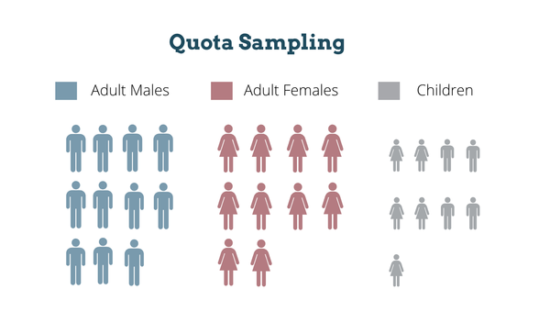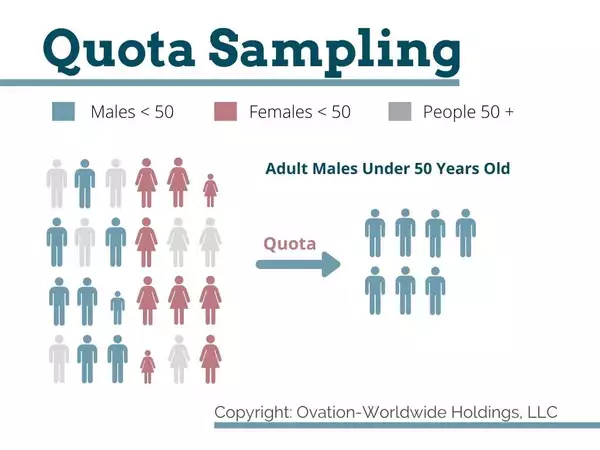Conceptualizing Quota Sampling in Market Research
Quota sampling makes market research convenient by allowing you to reach targets easily
You might also like…
When to Let AI Moderate Your Research—and When Not To
AI moderation can be a great way to improve efficiency of your qualitative research. Learn more below. By: Bart Barkosky Date: September 12, 2025...
Closing the Creativity Gap in Research Technology: How AI Enhances Surveys, Diaries, and Interviews
Learn how AI can help boost the creativity of your research technology and earn you better responses. By: OvationMR Research Team Date: September...
Using AI in Qualitative Research: Best Practices, Tools, and Real-World Examples
There are many different market research conferences to pick and choose from in any given calendar month. What are the pros and cons of so many options?...
Setting your company up for success may not happen overnight in the fast-paced and uber-competitive world of blooming businesses. But there are indeed practices you can rely on to speed up the process. One of these is excelling at the art of conducting market research.
It must be underscored; any market research initiative can result in time and resources wasted if it isn’t conducted with intelligent preparation, planning, and the proper methodology. Here, one way to win the race against the clock entails opting for quota sampling.

What is quota sampling?
Categorized as a non-probability sampling technique, ‘Quota Sampling’ is a research sampling method that enlists study participants until a relevant research category (or quota) has recruited enough respondents to reach holistic conclusions.
Unlike random sampling strategies, where every member of a target population has an equal chance of being selected, quota sampling relies on a methodology often referred to as: judgmental sampling, or convenience sampling. This technique requires that researchers use their experiential judgment regarding how many people they need to survey to acquire valid and authentic results.
For instance, let’s say that you have founded a startup that sells healthy, vegan food. To identify current food industry demands, you are undertaking market research to check people’s critique of traditional animal-fat-free food.
In your investigation, quota sampling will be the recruitment method of choice if you decide that you want to interview a total sample size of 100 regular restaurant clients and then start surveying the folks in question until you reach this number. With your focus on ensuring that you fulfill the desired quota, you don’t need to spend too much time wondering where the respondents will come from, but instead, the recruitment process. Your tactics can be as simple as administering an online survey to frequent dinner guests at a popular restaurant!
Given that quota sampling is a non-random sampling technique, it sometimes gets a bad rap. Some argue that it leads to biased results (while the significant research buying community refutes these concerns) because quota sampling allows researchers to specify control categories and mitigate sampling bias to a reasonable degree. Thus ensuring that the sample is as representative as possible.
Keeping in mind the same example as that of a vegan eatery owner, the quota you have determined doesn’t need to end with 100. Instead, you can create further specifications by dividing your quota into distinct categories.
The latter can be based on attributes such as gender, age, ethnicity, and spending habits. Thus, your quota of 100 participants can be completed, for instance, with 50 men and 50 women you interview at the places you visit. In addition, 25 of these 50 men and 25 of these 50 women can also be African American to ensure you achieve that racial representation. Thus, through dividing your quota into subcategories, you have essentially assigned a weightage to different traits within a target population and confirmed their feature representation in your study.
This step mitigates chances of bias as you won’t be making incomplete conclusions which would have been the case if you had excluded certain respondent traits from your market research.

The convenience of sampling with quota targets
Quota sample methodology manifests as a magical time-saving research technique because it prioritizes the availability of respondents. By directing you to survey whoever fits your criteria and is readily available whether they are:
- patrons who visit your retail stores,
- landscape professionals, or
- physicians and other healthcare providers,
the method prevents you from spending too many hours identifying every member of your target population.
With a random selection sample, which is the opposite of quota sampling, you’ll be required to create a prospective sample pool that includes every person who displays the characteristics you wish to study in your respondents.
Then conduct a survey with enough cases that when you aggregate completed survey population into subgroups, each one has a base size that is statistically significant for analysis.
Using the non-probability sampling method and setting quotas you can target your audiences directly and uses quotas to insure underrepresented subgroups targets are meet. By using quota targets one can reduce sample err and control selection bias to a great extent and come very close to matching probability sampling results in many cases.
To explain this in detail, let’s run with the example of the vegan restauranteur once again. In this case, if you were to use probability sampling, you’ll have to consider every individual in the country who fits the image of someone who consistently dines in a restaurant.
Once you start this consideration process, you will discover (and very soon be overwhelmed by) millions of people who fulfill this condition and can be worthy candidates for your study! Unfortunately, picking random names from this massive target population will be an ordeal in its own accord because you will have to spend several weeks deciding what sequence you will follow to recruit participants.
Because this non-probability technique helps you find respondents who match control categories’ criteria. It is also the sampling method of choice to target exact survey audiences without wasting time screening or qualifying hundreds or thousands of potential participants who don’t align with your quotas.
For instance, if you wanted to conduct case studies solely reviewing business school graduates’ career trajectories, quota sampling can help you approach folks who possess a business education and have made their mark in the sector.
Interviewing these participants will unearth your answers. There will be no need to survey graduates from other disciplines because you are not looking to compare results across subjects but focus on the entrepreneurial sphere.
Characteristics of quota sample projects may require more attention to ensure that your sample is representative by carefully assigning weights to attributes in control categories. At the same time, however, it acts as an antidote for the time-consuming concerns that often accompany probability sampling.
Examples of how to use quota sampling to advocate diversity and inclusion
If a company has purely commercial interests, it cannot expect to retain its clients. On the contrary, most successful ventures have leaders who possess drive and empathy for the customer experience. These motivations must also be made evident to customers by a business owners when they strive to make everyone feel valued.
With this regard, quota sampling can help you advocate for and implement inclusive business practices through your market research.
The purpose at hand is accomplished because quota sampling highlights interactions between the controlled respondent subcategories you create. In turn, the technique unearths differences in your customers’ lived experiences and opinions.
Armed with knowledge about the stark contrast between participant groups’ input, you can identify which clients feel marginalized while engaging with a business. This identification can be followed up by policies you can draft to help said clients feel accommodated.
For instance, consider that you are a consumer brand doing market research on the spending habits of a grocery store’s customers. If you use quota sampling, you can interview an equal percentage of men and women to check for variations in gender-based expenditure.
In this study, you’ll most likely conclude that each participant category spends more or less than the other based on its unique needs.
Women, you may find, could be bearing extra expenses purchasing feminine hygiene products. Knowing this, you might want to explore manufacturing a hygiene product that is more affordable for your female customers.
As part of another example, step into the shoes of a clothing brand owner who wants to see how she can serve her customers better.
Using quotas, you can conduct online focus groups with an equal percentage of clients who identify with straight and plus-size wear.
In the course of your research, you might stumble upon frustrations of the latter group, who might be angry with an apparel industry that doesn’t design size-inclusive clothing.
The responses you harness from the group in question can be evaluated against those given by people who shop for straight sizes. Comparing input from both categories can help you understand how to create products for plus-size customers that provide the same ease of access granted to a straight-size clientele.
Market research constitutes raw stones that are refined into a smooth road to roaring business success. Yet, when entrepreneurs are busy addressing their company’s growth on several fronts, they may not have the time to carry out time-consuming studies in line with such research.
This is where this targeted sample tactic enters the picture and performs well by helping you benefit from quick and convenient investigations.
Sometimes, in the absence of an easily accessible and organized sampling frame or a way to identify your whole target population, this technique may be the only resort you have to get some insights into your brand.
There is always a potential for researcher bias, nonresponse bias, and other sampling error however, the quota sample process while based in convenience sampling methods is considered more reliable than other non-probability sample methods.
A market research panel provider can also help guide you with sampling options you may not have thought of as well.
As a researcher, you must capitalize on these benefits and take your business to the next level by administering an excellent solution for your sampling woes.
Follow
OvationMR

Jim Whaley
Author
Jim Whaley is CEO of OvationMR and posts frequently on The Standard Ovation and other Industry Blogs.
OvationMR is a global provider of first-party data for those seeking solutions that require information for informed business decisions.
OvationMR is a leader in delivering insights and reliable results across a variety of industry sectors around the globe consistently for market research professionals and management consultants. Visit: https://www.ovationmr.com

Need help with new insights?
We are ready to offer you:




